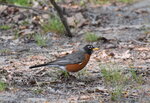 Narrowsburg
NarrowsburgLight Rain Fog/Mist, 43°
Wind: 8.1 mph
 Narrowsburg
Narrowsburg“When the red, red robin comes bob, bob bobbin’ along, along—there’ll be no more sobbing when he starts throbbing his own sweet song,” declared Harry Woods when he wrote …
Stay informed about your community and support local independent journalism.
Subscribe to The River Reporter today. click here
This item is available in full to subscribers.
Please log in to continue |

“When the red, red robin comes bob, bob bobbin’ along, along—there’ll be no more sobbing when he starts throbbing his own sweet song,” declared Harry Woods when he wrote the lyrics and music of the popular song, which comes to mind when American robins herald the arrival of the warmer seasons.
If you’ve been noticing a bright and alert grayish bird with a “red breast” bounding around your yard or “running” across the forest duff before plunging its beak into the ground and yanking out a hapless earthworm, you are likely looking at this industrious thrush.
Robins are abundant throughout the Upper Delaware River region. They frequently forage for earthworms on lawns and are therefore vulnerable to pesticide poisoning. For the sake of these cheery birds and other wildlife, go lightly when it comes to applying chemicals. Commit to seeking out less toxic alternatives and to appreciating the beauty of plants often considered to be weeds.
And consider heeding the good life advice inspired by our chipper neighbors in the iconic song. “Wake up, wake up, you sleepyhead/Get up, get up, get out of bed/Cheer up, cheer up the sun is red/Live, love, laugh and be happy.”
(Hear Al Jolson’s merry version of “When the Red, Red Robin” at www.youtube.com/watch?v=vtkhJ1xqw2o. )
Comments
No comments on this item Please log in to comment by clicking here